当前位置:
X-MOL 学术
›
Hypertens. Res.
›
论文详情
Our official English website, www.x-mol.net, welcomes your
feedback! (Note: you will need to create a separate account there.)
Luseogliflozin, a sodium-glucose cotransporter 2 inhibitor, preserves renal function irrespective of acute changes in the estimated glomerular filtration rate in Japanese patients with type 2 diabetes
Hypertension Research ( IF 4.3 ) Pub Date : 2020-03-19 , DOI: 10.1038/s41440-020-0426-0 Kentaro Kohagura 1, 2 , Hironori Yamasaki 3 , Hiroki Takano 3 , Yusuke Ohya 2 , Yutaka Seino 4
Hypertension Research ( IF 4.3 ) Pub Date : 2020-03-19 , DOI: 10.1038/s41440-020-0426-0 Kentaro Kohagura 1, 2 , Hironori Yamasaki 3 , Hiroki Takano 3 , Yusuke Ohya 2 , Yutaka Seino 4
Affiliation

|
Acute decline in estimated glomerular filtration rate (eGFR), a typical finding after initiating sodium-glucose cotransporter 2 (SGLT2) inhibitors, is associated with maintaining renal function in type 2 diabetes. However, the relationship between the magnitude of acute decline in eGFR and the course of eGFR thereafter is not known. A pooled analysis of four 52-week phase III trials of luseogliflozin 2.5 mg daily (or up to 5 mg daily) in Japanese patients with type 2 diabetes was conducted and stratified according to the tertile of magnitude of acute change in eGFR during the 2 weeks after initiation. The mean age, glycated hemoglobin, eGFR, and urinary albumin were 60 years, 7.8%, 79.6 mL/min/1.73 m 2 , and 62.7 mg/g Cr, respectively. Acute change in eGFR varied widely between patients ( N = 941; mean, −2.3; min, −35.5; max, 27.6). Patients with greater acute decline in eGFR, characterized by higher baseline eGFR and increased diuretic use, showed rapid recovery and maintenance of eGFR thereafter. Higher eGFR, longer duration of diabetes, and higher body mass index and diuretic use were associated with greater acute decline in eGFR. The course of eGFR from 12 to 52 weeks was maintained regardless of acute changes. Although acute changes in eGFR varied widely among patients with type 2 diabetes, the course of eGFR thereafter was stable regardless of the degree of acute changes.
中文翻译:

Luseogliflozin 是一种钠-葡萄糖协同转运蛋白 2 抑制剂,无论日本 2 型糖尿病患者的估计肾小球滤过率发生急性变化如何,都能保护肾功能
估计肾小球滤过率 (eGFR) 急剧下降,这是开始钠-葡萄糖协同转运蛋白 2 (SGLT2) 抑制剂后的典型发现,与维持 2 型糖尿病患者的肾功能有关。然而,eGFR 急剧下降的幅度与之后的 eGFR 进程之间的关系尚不清楚。对日本 2 型糖尿病患者使用 luseogliflozin 2.5 mg(或每天最多 5 mg)的四项 52 周 III 期试验进行汇总分析,并根据 2 周内 eGFR 急性变化幅度的三分位数进行分层启动后。平均年龄、糖化血红蛋白、eGFR 和尿白蛋白分别为 60 岁、7.8%、79.6 mL/min/1.73 m 2 和 62.7 mg/g Cr。eGFR 的急性变化在患者之间差异很大(N = 941;平均值,-2.3;最小值,-35.5;最大值,27.6)。eGFR 急剧下降较大的患者,其特征是基线 eGFR 较高和利尿剂使用增加,此后eGFR 显示出快速恢复和维持。较高的 eGFR、较长的糖尿病病程、较高的体重指数和利尿剂的使用与 eGFR 急剧下降的幅度更大有关。无论急性变化如何,eGFR 从 12 周到 52 周的过程都得以维持。尽管 eGFR 的急性变化在 2 型糖尿病患者中差异很大,但此后的 eGFR 病程是稳定的,无论急性变化的程度如何。无论急性变化如何,eGFR 从 12 周到 52 周的过程都得以维持。尽管 eGFR 的急性变化在 2 型糖尿病患者中差异很大,但此后的 eGFR 病程是稳定的,无论急性变化的程度如何。无论急性变化如何,eGFR 从 12 周到 52 周的过程都得以维持。尽管 eGFR 的急性变化在 2 型糖尿病患者中差异很大,但此后的 eGFR 病程是稳定的,无论急性变化的程度如何。
更新日期:2020-03-19
中文翻译:

Luseogliflozin 是一种钠-葡萄糖协同转运蛋白 2 抑制剂,无论日本 2 型糖尿病患者的估计肾小球滤过率发生急性变化如何,都能保护肾功能
估计肾小球滤过率 (eGFR) 急剧下降,这是开始钠-葡萄糖协同转运蛋白 2 (SGLT2) 抑制剂后的典型发现,与维持 2 型糖尿病患者的肾功能有关。然而,eGFR 急剧下降的幅度与之后的 eGFR 进程之间的关系尚不清楚。对日本 2 型糖尿病患者使用 luseogliflozin 2.5 mg(或每天最多 5 mg)的四项 52 周 III 期试验进行汇总分析,并根据 2 周内 eGFR 急性变化幅度的三分位数进行分层启动后。平均年龄、糖化血红蛋白、eGFR 和尿白蛋白分别为 60 岁、7.8%、79.6 mL/min/1.73 m 2 和 62.7 mg/g Cr。eGFR 的急性变化在患者之间差异很大(N = 941;平均值,-2.3;最小值,-35.5;最大值,27.6)。eGFR 急剧下降较大的患者,其特征是基线 eGFR 较高和利尿剂使用增加,此后eGFR 显示出快速恢复和维持。较高的 eGFR、较长的糖尿病病程、较高的体重指数和利尿剂的使用与 eGFR 急剧下降的幅度更大有关。无论急性变化如何,eGFR 从 12 周到 52 周的过程都得以维持。尽管 eGFR 的急性变化在 2 型糖尿病患者中差异很大,但此后的 eGFR 病程是稳定的,无论急性变化的程度如何。无论急性变化如何,eGFR 从 12 周到 52 周的过程都得以维持。尽管 eGFR 的急性变化在 2 型糖尿病患者中差异很大,但此后的 eGFR 病程是稳定的,无论急性变化的程度如何。无论急性变化如何,eGFR 从 12 周到 52 周的过程都得以维持。尽管 eGFR 的急性变化在 2 型糖尿病患者中差异很大,但此后的 eGFR 病程是稳定的,无论急性变化的程度如何。











































 京公网安备 11010802027423号
京公网安备 11010802027423号